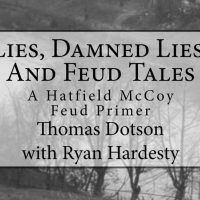Blood-thirsty and Stupid—and They Couldn’t Shoot Straight
[One of the things that has always amazed me about Thomas is his ability to zero in on the absurdities of the many feud tales. I had read many of these stories, in book after book, for years, and never thought to question them. They are presented as fact, with enough convincing detail to make them seem real. Thomas, however, approaches these tales with impeccable logic coupled with an encyclopedic knowledge of feud-related history. A major element in Thomas’s work involves whittling away at the accepted body of feud-tales, using actual court records and other documents to set the record straight. Thomas writes frequently about how the standard story of the feud has grown over the years as outside writers, from John Spears to Virgil Carrington Jones to Dean King, freely add fictional material into the middle of historical events until the two are indistinguishable to the average reader. One of the main contributions to feud history that Thomas has made, in my opinion, is the way he has systematically dismantled 120 years of feud fiction, downsizing the tall tales passing themselves off as historical events, so that the real history of these real people can at long last be seen. – RH]
Three things which appear repeatedly in Dean King’s supersized feud story are bloodlust, stupidity and poor marksmanship. If, as King says, Devil Anse was seeking to kill Ran’l McCoy during 1883-1887, he was blood-thirsty. His execution of the three McCoys who killed his brother would have satiated the desire for revenge for anyone who was not a psychopathic killer. If Devil Anse did not realize that he could send just about any member of his family over the age of ten to lurk in the edge of the woods surrounding the home of Ran’l McCoy, and pick off the old man as he went about his daily chores, then Devil Anse was stupid.
Under oath in Johnse Hatfield’s trial, Jim McCoy was asked: When did the trouble between the two families start?”
Jim answered: “It started at the 1882 election.” Nothing about his uncle Asa Harmon being murdered by Hatfields in 1865, nothing about his uncle having a pig stolen in 1878, and nothing about his sister being impregnated and abandoned by Johnse in 1880.
Then the prosecutor asked Jim what happened between the 1882 election events and the New Yeaar’s raid on his father’s home. Jim McCoy, with the strongest possible motive to make the ‘feud’ as big and bloody as possible, said: “We tried to get them arrested, but we NEVER had ANY trouble.” There is a plethora of documentary evidence for the things Jim McCoy swore happened, but there is absolutely NO historical evidence for the dozens of “feud events” that appear in the feud tales before 1882 and during the five years between 1882 and December of 1887. With no real evidence for their yarns, and no dead bodies, the feud writers are forced to present the Hatfields as poor marksmen. Men who shot squirrels out of the tops of tall trees with a .22 rifle are said to be unable to score a torso hit with a high-powered Winchester from the free throw line to the basket.
As the only documented death between August 9, 1882 and January 1, 1888 was the killing of Jeff McCoy in September, 1886, with Perry Cline telling the Governor that Tom Wallace–NOT any Hatfield–killed his nephew Jeff, all the “battles” conjured up by King for his fantastic yarn had to feature poor marksmanship, because there were NO corpses or court records to back up King’s yarns.
Thus King has Cap Hatfield firing several shots from a Winchester rifle at Jeff McCoy while McCoy was swimming across a river King says was only forty feet wide (it’s actually about three times that wide), missing him every time. Then King has a seven-man hit squad of mountain hunters hurling a fusillade of bullets at three men riding abreast from an ambush located only thirty feet off the road, and succeeding only in hitting one man in the knee and another in the shoulder. Like Glenn Campbell in “True Grit,” they did manage to kill the horses.
King’s poor marksmanship on the part of the Hatfields includes a tale of Cap Hatfield mistaking one of his Hatfield cousins for Ran’l McCoy, at a distance of less than seventy yards. At this distance, a mountain hunter should be able to hit either coat button he aimed at, but all Cap could manage was another knee-capping. After reading of these repeated knee shootings, one begins to wonder if the Cosa Nostra got its “kneecapping” thing from Cap Hatfield.
King is just the latest in a long line of feud story-tellers who feature poor marksmanship on the part of the Hatfields. G. Elliott Hatfield, in his 1976 book, The Hatfields, had Elias Hatfield shooting six times at Pharmer McCoy, with the gun so close to McCoy’s face that every shot powder-burned McCoy’s face, yet he missed every time. To top it off, Elias shot six times with a revolver that had only five live cartridges in the cylinder!
An interesting twist to King’s tale of sorry marksmanship on the part of Devil Anse and his crew is that the poor shooting was strictly a daytime phenomenon. In King’s yarn, the Hatfield gang fired hundreds of shots at dozens of men in daylight, with Jeff McCoy being the only fatality. The same gang shot at six McCoys during the dark of night, and killed five of them. Go figure.
